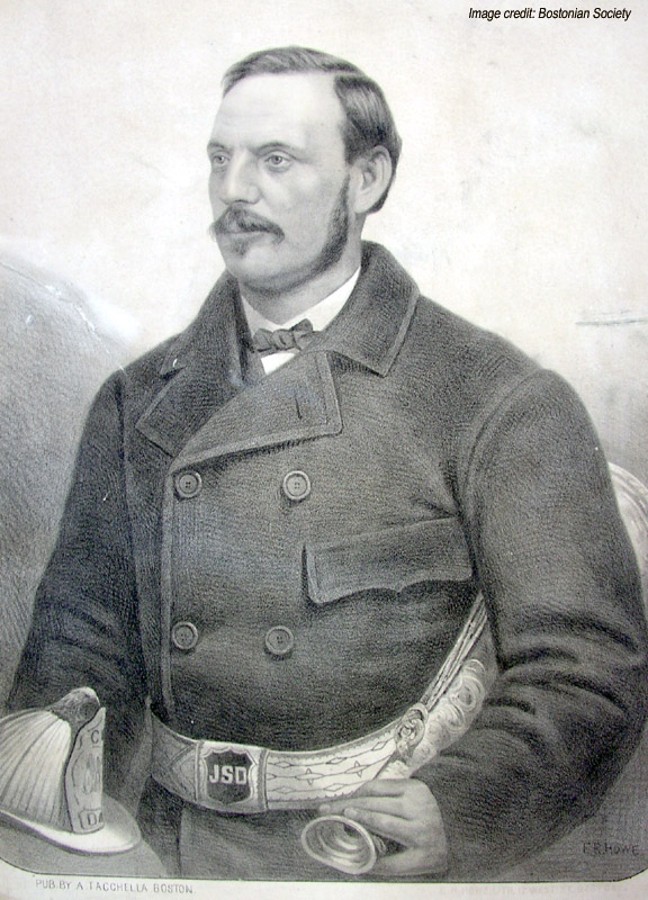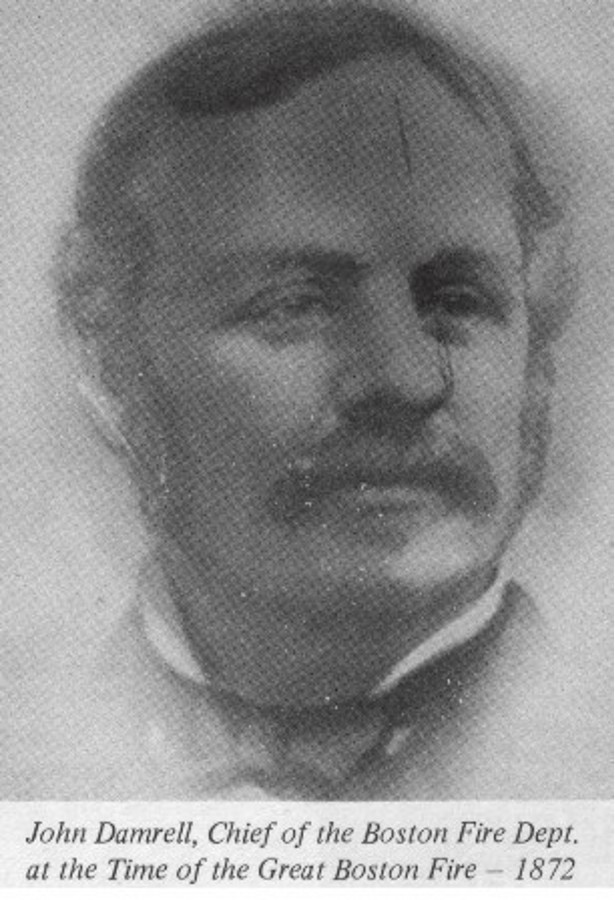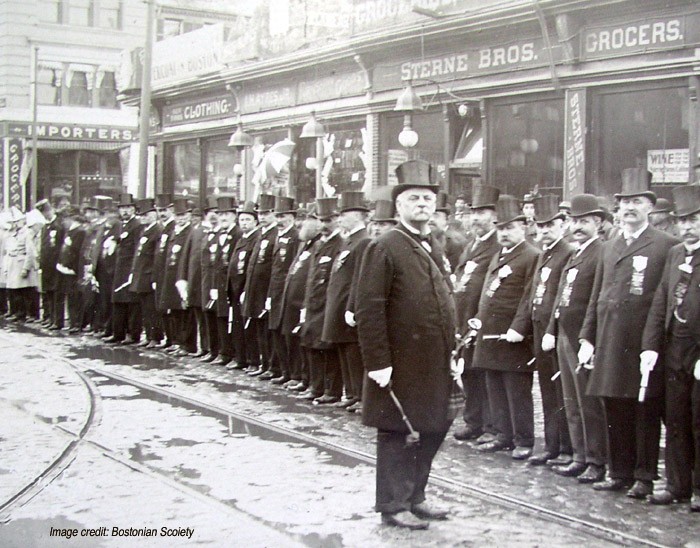John Damrell was born in Boston on June 29, 1829. His parents were Samuel Edward and Ann Stanhope Damrell. He moved to East Cambridge in 1830. Both parents were dead by 1840. He had a guardian appointed at that time and began work very young. He began his entrepreneurial endeavors with James Long. His construction business, Damrell and Long, continued until 1873.
As he began to establish himself in the building trade, John also joined the Boston Fire Department as a volunteer fireman like "his father and uncles before him". Fire departments in cities and towns across the country were largely made up of volunteers. There was a lack of formal training and consistent discipline among most fire companies before the Civil War. With the introduction of steam fire engines came the gradual shift to professional, trained urban firefighters.
Damrell was recognized as a leader by his fellow firemen and quickly rose through the ranks. His self-discipline, intelligence, and facility with steam fire engines inspired the confidence of his peers and superiors. During this period Damrell was elected to represent his ward on Boston's city council, or Common Council, as it was called. Early in his career, Damrell learned about the workings and politics of city government and started to build relationships that would help him later as Chief of the Boston Fire Department. In that role he would work with various committees and groups in city and state government and foster alliances to get legislation passed to improve fire and building codes. During this time John and Susan Damrell start a family. They eventually had five children, but two died in early childhood, and one daughter died shortly after her marriage.
Damrell was elected to the position of Chief Engineer of Boston Fire Department in 1866. His age was 38. He immediately starts to warn the city officials about the danger of fire in the business district. He is concerned with the water supply, shortage of fire hydrants, lack of fire equipment, and the density of tall buildings with wooded mansard roofs in the district. Recognizing the need for long-term improvements in construction practices, he also begins to advocate for the establishment of a building department and building inspection services with the authority to enforce fire and building codes. Boston finally passes an ordinance for "Regulation and Inspection of Buildings" in June of 1871.
After Chicago is destroyed by fire in 1871, Damrell goes to view the ruins and learn what he could about the cause and progression of that devastating conflagration. The images of Chicago's ruins haunt him, for he knows that the same thing could happen in Boston. In his report of findings after his visit to Chicago, Damrell again advocates for improvements, but change is frustratingly slow, too slow to prevent Boston's Great Fire in 1872.
In the aftermath of the Great Fire, a Commission is established to oversee the Boston Fire Department and Damrell resigned as Fire Chief. Damrell was one of the organizers and was also elected the first president of the newly founded organization called the National Association of Fire Engineers (NAFE). He continued his close association with NAFE as a member of the Executive Committee. He also maintained his ties serving as the president of the Massachusetts State Firemen's Association, and ongoing service to the Charitable Relief Associations of the Boston Fire Department.
After leaving the Boston Fire Department at age 45, Damrell had several career options to consider. He could have retired, he could have focused all his efforts on the further growth of his successful construction and realty business, or he could have re-entered Boston or state politics. Damrell chose to reenter public service and fight to improve the safety of Boston's buildings. Both his sons also served in the Building Department, but eventually his eldest son, E.S., assumed leadership of the family business, while Charles, the younger son, became his right-hand man as Chief Clerk of the department. Soon after becoming Building Commissioner, Damrell convened a group of builders, architects, and owners to confer on amendments to the building laws and regulations of building construction.
Damrell continues his persistent advocacy for building codes through his report to City Council on "Unsafe Buildings in Case of Fire" (issue of fire safety in hotels, boarding houses, factories, mills, offices, workshops – enforcement of Acts of 1873). In 1891 Damrell joins representatives of the Underwriters, Architects, Builders, Building Inspectors, Fire Engineers (fire chiefs) in supporting "general suggestions" for building laws to be recommended to all state legislatures. This is a precursor to the joint effort that resulted in the 1905 National Model Building Code. At the 20th Annual Convention of NAFE held in 1892, Damrell again provides input to NAFE proceedings, e.g., "Boston is the only city limiting the height and area of buildings. This law is due to Capt. Damrell, who has furnished me with advance sheets of the new building laws of Boston." In his final Annual Report for the Building Department submitted in February of 1903, Damrell includes records for gas and elevator accidents which gives victims' names and circumstances, and causes of injury or death. It is clear that preventable deaths continue to haunt him and that he habitually gathered data related to safety issues that could be addressed by improvements procedures or amendments to codes. After twenty years of Damrell's advocacy and collaboration with leaders of national associations of architects, fire chiefs, and underwriters, the first National Model Building Code was published. In 1901 he delivers a speech to a gathering of the Massachusetts Fire Chiefs Association entitled: The Fire Department; Past, Present and Future.
John S. Damrell died November 3, 1905, at the age of 77. He was buried in the family plot at Forest Hills Cemetery, Boston. His grave is near the Fireman's Memorial. He had served Boston and the cause of firefighting, fire prevention and fire safety for 58 years. In 1905 the first National Model Building Code is established.
John Damrell was born in Boston on June 29, 1829. His parents were Samuel Edward and Ann Stanhope Damrell. He moved to East Cambridge in 1830. Both parents were dead by 1840. He had a guardian appointed at that time and began work very young. He began his entrepreneurial endeavors with James Long. His construction business, Damrell and Long, continued until 1873.
As he began to establish himself in the building trade, John also joined the Boston Fire Department as a volunteer fireman like "his father and uncles before him". Fire departments in cities and towns across the country were largely made up of volunteers. There was a lack of formal training and consistent discipline among most fire companies before the Civil War. With the introduction of steam fire engines came the gradual shift to professional, trained urban firefighters.
Damrell was recognized as a leader by his fellow firemen and quickly rose through the ranks. His self-discipline, intelligence, and facility with steam fire engines inspired the confidence of his peers and superiors. During this period Damrell was elected to represent his ward on Boston's city council, or Common Council, as it was called. Early in his career, Damrell learned about the workings and politics of city government and started to build relationships that would help him later as Chief of the Boston Fire Department. In that role he would work with various committees and groups in city and state government and foster alliances to get legislation passed to improve fire and building codes. During this time John and Susan Damrell start a family. They eventually had five children, but two died in early childhood, and one daughter died shortly after her marriage.
Damrell was elected to the position of Chief Engineer of Boston Fire Department in 1866. His age was 38. He immediately starts to warn the city officials about the danger of fire in the business district. He is concerned with the water supply, shortage of fire hydrants, lack of fire equipment, and the density of tall buildings with wooded mansard roofs in the district. Recognizing the need for long-term improvements in construction practices, he also begins to advocate for the establishment of a building department and building inspection services with the authority to enforce fire and building codes. Boston finally passes an ordinance for "Regulation and Inspection of Buildings" in June of 1871.
After Chicago is destroyed by fire in 1871, Damrell goes to view the ruins and learn what he could about the cause and progression of that devastating conflagration. The images of Chicago's ruins haunt him, for he knows that the same thing could happen in Boston. In his report of findings after his visit to Chicago, Damrell again advocates for improvements, but change is frustratingly slow, too slow to prevent Boston's Great Fire in 1872.
In the aftermath of the Great Fire, a Commission is established to oversee the Boston Fire Department and Damrell resigned as Fire Chief. Damrell was one of the organizers and was also elected the first president of the newly founded organization called the National Association of Fire Engineers (NAFE). He continued his close association with NAFE as a member of the Executive Committee. He also maintained his ties serving as the president of the Massachusetts State Firemen's Association, and ongoing service to the Charitable Relief Associations of the Boston Fire Department.
After leaving the Boston Fire Department at age 45, Damrell had several career options to consider. He could have retired, he could have focused all his efforts on the further growth of his successful construction and realty business, or he could have re-entered Boston or state politics. Damrell chose to reenter public service and fight to improve the safety of Boston's buildings. Both his sons also served in the Building Department, but eventually his eldest son, E.S., assumed leadership of the family business, while Charles, the younger son, became his right-hand man as Chief Clerk of the department. Soon after becoming Building Commissioner, Damrell convened a group of builders, architects, and owners to confer on amendments to the building laws and regulations of building construction.
Damrell continues his persistent advocacy for building codes through his report to City Council on "Unsafe Buildings in Case of Fire" (issue of fire safety in hotels, boarding houses, factories, mills, offices, workshops – enforcement of Acts of 1873). In 1891 Damrell joins representatives of the Underwriters, Architects, Builders, Building Inspectors, Fire Engineers (fire chiefs) in supporting "general suggestions" for building laws to be recommended to all state legislatures. This is a precursor to the joint effort that resulted in the 1905 National Model Building Code. At the 20th Annual Convention of NAFE held in 1892, Damrell again provides input to NAFE proceedings, e.g., "Boston is the only city limiting the height and area of buildings. This law is due to Capt. Damrell, who has furnished me with advance sheets of the new building laws of Boston." In his final Annual Report for the Building Department submitted in February of 1903, Damrell includes records for gas and elevator accidents which gives victims' names and circumstances, and causes of injury or death. It is clear that preventable deaths continue to haunt him and that he habitually gathered data related to safety issues that could be addressed by improvements procedures or amendments to codes. After twenty years of Damrell's advocacy and collaboration with leaders of national associations of architects, fire chiefs, and underwriters, the first National Model Building Code was published. In 1901 he delivers a speech to a gathering of the Massachusetts Fire Chiefs Association entitled: The Fire Department; Past, Present and Future.
John S. Damrell died November 3, 1905, at the age of 77. He was buried in the family plot at Forest Hills Cemetery, Boston. His grave is near the Fireman's Memorial. He had served Boston and the cause of firefighting, fire prevention and fire safety for 58 years. In 1905 the first National Model Building Code is established.
Family Members
Sponsored by Ancestry
Advertisement
Explore more
Sponsored by Ancestry
Advertisement





